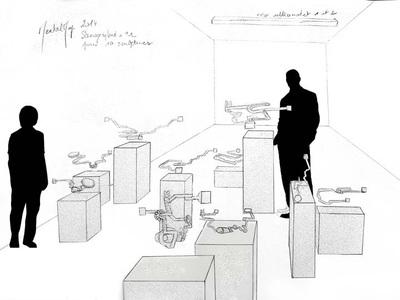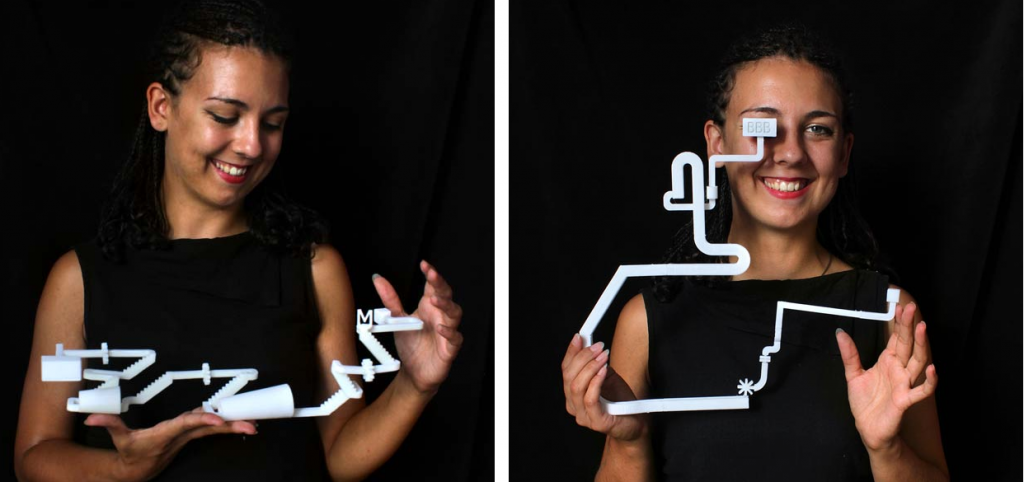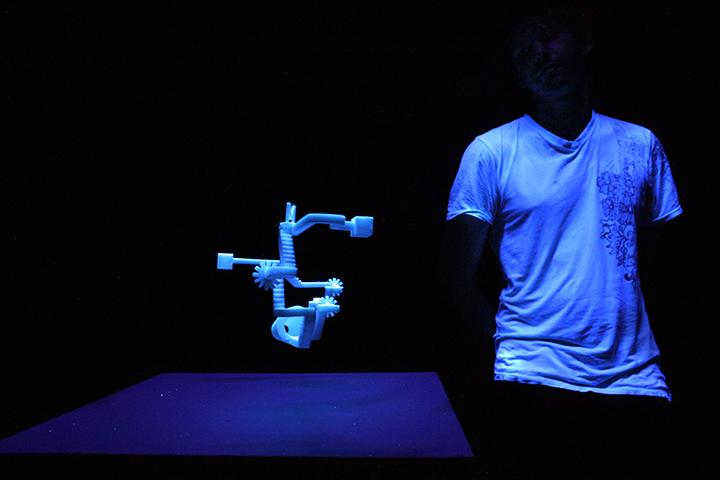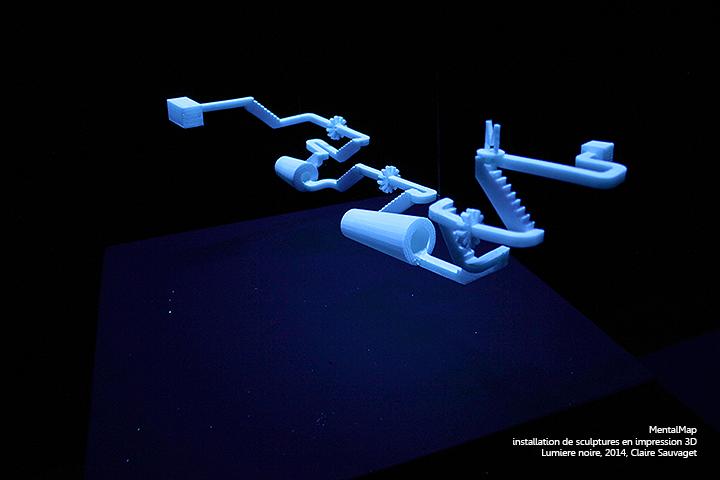French digital artist and sculptor Claire Sauvaget takes us along with her on her daily commute. We trail behind her down stairs, around corners, onto crowded train platforms, and through narrow corridors. We speed in a train car underneath the busy streets of Toulouse, France, Sauvaget’s home, and emerge into daylight after scaling yet another flight of stairs from the underground. Our route, visualized by Sauvaget as solid, geometrical forms, narrows in some stretches, leaving space for only one person and their thoughts, which occasionally manifest as starbursts or asterisks and, in one instance, a spiky globe in the artist’s 3D printed models of her commute. She calls the work, three small printed diagrams of her commute, Mental Map.
Like other modern artists, Sauvaget tackles the subject of urban alienation, that particular brand of loneliness that is exacerbated rather than ameliorated by the crowd. As a digital artist, she is uniquely poised to capture life in a high-tech world using the high-tech tools at her disposal. The artist provides her viewers with a concrete, three-dimensional diagram or model of what it looks like inside her mind as her body moves through space and time. Like many creative people, Sauvauget creates as she goes about other tasks — like traversing sidewalks, passing through turnstiles, choosing a seat on the train — solving problems, noticing connections and experiencing those “Eureka!” moments that inspire works like Mental Map.
Sauvaget’s three pieces in this overall sculptural work are small — seemingly no more than about 40 cm long. They’re 3D printed in white ABS.
When the three pieces in Mental Map were exhibited at le festival d’Arts plastiques du Carla-Bayle, 20e édition (The 20th Annual Carla-Bayle Plastic Arts Festival) in Ariège, France, they were suspended above the pedestals in low light so that they were less distinct, something like the sensation of visualizing what’s in your head or explaining your thoughts, which seem concrete to you, to another person.
Sauvaget completed her Masters in Fine Art at the Birmingham Institute of Art and Design in the UK in 2009. She also has a Masters degree in Digital Art from the University of Toulouse-Jean Jaurès in Toulouse, France. She exhibits her work in France and England at digital art festivals. She is a member of an arts collective, the Patchwork Emerging Arts Association, which promotes digital art in Europe and specifically in France. Additionally, the very busy Sauvaget hosts a radio show in Toulouse called “Déambulations Urbaines” (“Urban Wanderings”) which, she says, “presents different aspects of the sound arts through various sound artwork inspired by the town.”
Sauvaget’s work frequently, in one way or another, investigates the neurological phenomenon of synesthesia, when the stimulation of one cognitive or sensory pathway leads to an involuntary, automatic experience in a seemingly unrelated, second cognitive or sensory pathway. For instance, one of the more common forms of synesthesia is called grapheme-color synesthesia, when a person associates letters and numbers with colors. In other words, “A” might equal “purple.”
For Sauvaget, it seems, the complex cognitive experience of the commute becomes a solid, floating map, a pathway in the brain that she translates into 3D forms that resemble one of those  children’s toys, the marble track, in which the marble goes zooming continuously, sometimes gaining momentum, at other times coming nearly to a halt, along a predetermined route. For Sauvaget, this is what walking and thinking looks like.
children’s toys, the marble track, in which the marble goes zooming continuously, sometimes gaining momentum, at other times coming nearly to a halt, along a predetermined route. For Sauvaget, this is what walking and thinking looks like.
Sauvaget’s 3D printed models, while fascinating and puzzling, are strangely disconnected from the drawings and digital renderings she created prior to printing. She also produced the solid works in clay and expanded polystyrene but seems to have felt that the logical realization of her Mental Maps, lay in the digital and high-tech world of 3D printing.
The 3D printed works have a mechanistic appearance, although of a machine that is assembled haphazardly and therefore won’t function in a logical way. Along with that peculiar disconnect, however, there’s a sense of playfulness that makes these odd sculptures really successful testaments to the feeling that, when making the twice-daily commute, you are on automatic pilot in a kind of urban obstacle course.
Do Sauvaget’s works strike a chord with you? Let us know how you feel about this project in the 3D Printed Mental Maps forum thread over at 3DPB.com.
Subscribe to Our Email Newsletter
Stay up-to-date on all the latest news from the 3D printing industry and receive information and offers from third party vendors.
You May Also Like
Printing Money Episode 17: Recent 3D Printing Deals, with Alex Kingsbury
Printing Money is back with Episode 17! Our host, NewCap Partners‘ Danny Piper, is joined by Alex Kingsbury for this episode, so you can prepare yourself for smart coverage laced...
Insights from Cantor Fitzgerald on AM’s Q1 2024 Landscape
A recent survey by Cantor Fitzgerald sheds light on the persistent challenges within the additive manufacturing (AM) industry in the first quarter of 2024. Based on responses from 38 industry...
3D Printing Financials: Xometry’s Scaling up and Strong Start to 2024
Xometry (Nasdaq: XMTR) kicked off 2024 with strong results, boosting its marketplace and technology to new heights. Both revenue and gross margin soared, fueled by an expanding global network of...
3D Printing Financials: Desktop Metal Targets Recovery Amid Net Losses and Revenue Downturn
Despite facing a decline in revenue and the persistent challenges of a tight economic climate, Desktop Metal (NYSE: DM) is making strides toward operational efficiency. The first quarter of 2024...



































